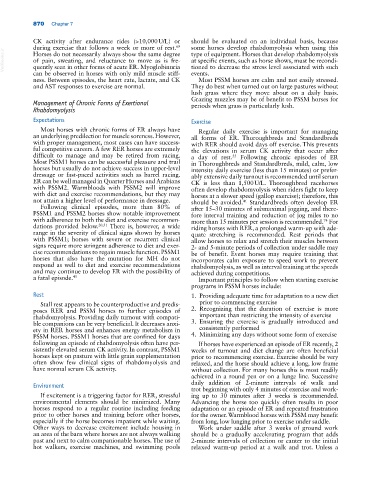Page 904 - Adams and Stashak's Lameness in Horses, 7th Edition
P. 904
870 Chapter 7
CK activity after endurance rides (>10,000 U/L) or should be evaluated on an individual basis, because
69
during exercise that follows a week or more of rest. some horses develop rhabdomyolysis when using this
VetBooks.ir of pain, sweating, and reluctance to move as is fre at specific events, such as horse shows, must be recondi
type of equipment. Horses that develop rhabdomyolysis
Horses do not necessarily always show the same degree
quently seen in other forms of acute ER. Myoglobinuria
tioned to decrease the stress level associated with such
can be observed in horses with only mild muscle stiff events.
ness. Between episodes, the heart rate, lactate, and CK Most PSSM horses are calm and not easily stressed.
and AST responses to exercise are normal. They do best when turned out on large pastures without
lush grass where they move about on a daily basis.
Grazing muzzles may be of benefit to PSSM horses for
Management of Chronic Forms of Exertional periods when grass is particularly lush.
Rhabdomyolysis
Expectations Exercise
Most horses with chronic forms of ER always have Regular daily exercise is important for managing
an underlying predilection for muscle soreness. However, all forms of ER. Thoroughbreds and Standardbreds
with proper management, most cases can have success with RER should avoid days off exercise. This prevents
ful competitive careers. A few RER horses are extremely the elevations in serum CK activity that occur after
difficult to manage and may be retired from racing. a day of rest. Following chronic episodes of ER
55
Most PSSM1 horses can be successful pleasure and trail in Thoroughbreds and Standardbreds, mild, calm, low
horses but usually do not achieve success in upper‐level intensity daily exercise (less than 15 minutes) or prefer
dressage or fast‐paced activities such as barrel racing. ably extensive daily turnout is recommended until serum
ER can be well managed in Quarter Horses and Arabians CK is less than 1,500 U/L. Thoroughbred racehorses
with PSSM2. Warmbloods with PSSM2 will improve often develop rhabdomyolysis when riders fight to keep
with diet and exercise recommendations, but they may horses at a slower speed (gallop exercise); therefore, this
not attain a higher level of performance in dressage. should be avoided. Standardbreds often develop ER
41
Following clinical episodes, more than 80% of after 15–30 minutes of submaximal jogging, and there
PSSM1 and PSSM2 horses show notable improvement fore interval training and reduction of jog miles to no
with adherence to both the diet and exercise recommen more than 15 minutes per session is recommended. For
74
dations provided below. 20,31 There is, however, a wide riding horses with RER, a prolonged warm‐up with ade
range in the severity of clinical signs shown by horses quate stretching is recommended. Rest periods that
with PSSM1; horses with severe or recurrent clinical allow horses to relax and stretch their muscles between
signs require more stringent adherence to diet and exer 2‐ and 5‐minute periods of collection under saddle may
cise recommendations to regain muscle function. PSSM1 be of benefit. Event horses may require training that
horses that also have the mutation for MH do not incorporates calm exposure to speed work to prevent
respond as well to diet and exercise recommendations rhabdomyolysis, as well as interval training at the speeds
and may continue to develop ER with the possibility of achieved during competitions.
a fatal episode. 45 Important principles to follow when starting exercise
programs in PSSM horses include:
Rest 1. Providing adequate time for adaptation to a new diet
Stall rest appears to be counterproductive and predis prior to commencing exercise
poses RER and PSSM horses to further episodes of 2. Recognizing that the duration of exercise is more
rhabdomyolysis. Providing daily turnout with compati important than restricting the intensity of exercise
ble companions can be very beneficial. It decreases anxi 3. Ensuring the exercise is gradually introduced and
ety in RER horses and enhances energy metabolism in consistently performed
PSSM horses. PSSM1 horses that are confined for days 4. Minimizing any days without some form of exercise
following an episode of rhabdomyolysis often have per If horses have experienced an episode of ER recently, 2
sistently elevated serum CK activity. In contrast, PSSM1 weeks of turnout and diet change are often beneficial
horses kept on pasture with little grain supplementation prior to recommencing exercise. Exercise should be very
often show few clinical signs of rhabdomyolysis and relaxed, and the horse should achieve a long, low frame
have normal serum CK activity. without collection. For many horses this is most readily
achieved in a round pen or on a lunge line. Successive
Environment daily addition of 2‐minute intervals of walk and
trot beginning with only 4 minutes of exercise and work
If excitement is a triggering factor for RER, stressful ing up to 30 minutes after 3 weeks is recommended.
environmental elements should be minimized. Many Advancing the horse too quickly often results in poor
horses respond to a regular routine including feeding adaptation or an episode of ER and repeated frustration
prior to other horses and training before other horses, for the owner. Warmblood horses with PSSM may benefit
especially if the horse becomes impatient while waiting. from long, low lunging prior to exercise under saddle.
Other ways to decrease excitement include housing in Work under saddle after 3 weeks of ground work
an area of the barn where horses are not always walking should be a gradually accelerating program that adds
past and next to calm companionable horses. The use of 2‐minute intervals of collection or canter to the initial
hot walkers, exercise machines, and swimming pools relaxed warm‐up period at a walk and trot. Unless a

